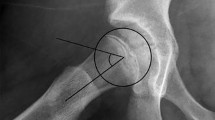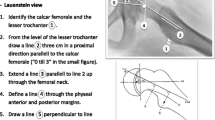Abstract
Background
Slipped capital femoral epiphysis (SCFE) is occurring in greater numbers, at increasingly younger ages, and more frequently bilaterally (BL-SCFE). Obesity is one risk factor for SCFE. However, it is unclear whether postoperative decreases or increases in body mass index (BMI) alter the risk of subsequent contralateral SCFE.
Questions/purposes
We therefore determined whether (1) BMI percentile was a risk factor for BL-SCFE; and (2) postoperative increases and/or decreases in BMI percentile influenced the risk for BL-SCFE.
Methods
We retrospectively reviewed the records of 502 patients surgically treated for SCFE and identified 138 (27%) with BL-SCFE and 364 (73%) with unilateral SCFE (UL-SCFE); 173 patients, 60 (35%) with BL-SCFE and 113 (65%) with UL-SCFE met our inclusion criteria. Risk factors included sex, age, slip stability, slip chronicity, slip angle, and obesity. Percentile BMI was recorded at the time of first SCFE surgery, at the time of last followup for patients undergoing UL-SCFE, and at the time of second SCFE surgery for patients undergoing BL-SCFE.
Results
Sex, age, slip stability, and slip angle were not associated with BL-SCFE. Postoperative obesity (odds ratio [OR], 3.5; 95% confidence interval [CI], 1.2–9.7) and acute slip chronicity (OR, 2.9; 95% CI, 1.3–6.7) had higher risks for sequential BL-SCFE. Obese patients who became nonobese postoperatively had a decreased risk of sequential BL-SCFE compared with those who remained obese (OR, 0.16; 95% CI, 1.2–116.5).
Conclusions
Only postoperative obesity and an acute slip were risk factors for sequential BL-SCFE. BMI reduction to lower than the 95% percentile after SCFE surgery was associated with lower risk for BL-SCFE development. The data suggest early supervised therapeutic weight management programs for patients treated for UL-SCFE are important to reduce risk of subsequent SCFE.
Level of Evidence
Level III, prognostic study. See Guidelines for Authors for a complete description of levels of evidence.




Similar content being viewed by others
References
Adamczyk MJ, Weiner DS, Nugent A, McBurney D, Horton WE Jr. Increased chondrocyte apoptosis in growth plates from children with slipped capital femoral epiphysis. J Pediatr Orthop. 2005;25:440–444.
Anonymous. Healthy Weight: Assessing Your Weight: BMI: About BMI in Children and Adolescents. Atlanta, GA, USA: Centers for Disease and Prevention Control. Available at: www.cdc.gov/healthyweight/assessing/bmi/childrens_bmi/about_childrens_bmi.html#How is BMI calculated. Accessed December 15, 2011.
Aronsson DD, Loder RT, Breur GJ, Weinstein SL. Slipped capital femoral epiphysis: current concepts. J Am Acad Orthop Surg. 2006;14:666–679.
Bass JL, Bhatia A, Boas FE, Sansary J, Rauch D. Validation of a body mass index nomogram for children as an obesity screening tool in young children. Clin Pediatr (Phila). 2006;45:718–724.
Bedogni G, Iughetti L, Ferrari M, Malavolti M, Poli M, Bernasconi S, Battistini N. Sensitivity and specificity of body mass index and skinfold thicknesses in detecting excess adiposity in children aged 8–12 years. Ann Hum Biol. 2003;30:132–139.
Bhatia NN, Pirpiris M, Otsuka NY. Body mass index in patients with slipped capital femoral epiphysis. J Pediatr Orthop. 2006;26:197–199.
Bidwell TA, Stott SN. Sequential slipped capital femoral epiphyses: who is at risk for a second slip? ANZ J Surg. 2006;76:973–976.
Boyer DW, Mickelson MR, Ponseti IV. Slipped capital femoral epiphysis. Long-term follow-up study of one hundred and twenty-one patients. J Bone Joint Surg Am. 1981;63:85–95.
Castro FP Jr, Bennett JT, Doulens K. Epidemiological perspective on prophylactic pinning in patients with unilateral slipped capital femoral epiphysis. J Pediatr Orthop. 2000;20:745–748.
Clemente L, Moreira P, Oliveira B, Almeida MD. [Body mass index: sensitivity and specificity] [in Portuguese]. Acta Med Port. 2004;17:353–358.
Cole TJ, Bellizzi MC, Flegal KM, Dietz WH. Establishing a standard definition for child overweight and obesity worldwide: international survey. BMJ. 2000;320:1240–1243.
Cole TJ, Flegal KM, Nicholls D, Jackson AA. Body mass index cut offs to define thinness in children and adolescents: international survey. BMJ. 2007;335:194.
Collinge CA, Lebus G, Gardner MJ, Gehrig L. A comparison of quantitative ultrasound of the calcaneus with dual-energy x-ray absorptiometry in hospitalized orthopaedic trauma patients. J Orthop Trauma. 2010;24:176–180.
Dietz WH, Robinson TN. Use of the body mass index (BMI) as a measure of overweight in children and adolescents. J Pediatr. 1998;132:191–193.
Farias Junior JC, Konrad LM, Rabacow FM, Grup S, Araujo VC. Sensitivity and specificity of criteria for classifying body mass index in adolescents. Rev Saude Publica. 2009;43:53–59.
Gardner MJ, Brophy RH, Demetrakopoulos D, Koob J, Hong R, Rana A, Lin JT, Lane JM. Interventions to improve osteoporosis treatment following hip fracture. A prospective, randomized trial. J Bone Joint Surg Am. 2005;87:3–7.
Gardner MJ, Demetrakopoulos D, Shindle MK, Griffith MH, Lane JM. Prevention and treatment of osteoporotic fractures. Minerva Med. 2005;96:343–352.
Gardner MJ, Flik KR, Mooar P, Lane JM. Improvement in the undertreatment of osteoporosis following hip fracture. J Bone Joint Surg Am. 2002;84:1342–1348.
Gelberman RH, Cohen MS, Shaw BA, Kasser JR, Griffin PP, Wilkinson RH. The association of femoral retroversion with slipped capital femoral epiphysis. J Bone Joint Surg Am. 1986;68:1000–1007.
Hell AK. [Slipped capital femoral epiphysis and overweight] [in German]. Orthopade. 2005;34:658–663.
Kallio PE, Paterson DC, Foster BK, Lequesne GW. Classification in slipped capital femoral epiphysis. Sonographic assessment of stability and remodeling. Clin Orthop Relat Res. 1993;294:196–203.
Kocher MS, Bishop JA, Hresko MT, Millis MB, Kim YJ, Kasser JR. Prophylactic pinning of the contralateral hip after unilateral slipped capital femoral epiphysis. J Bone Joint Surg Am. 2004;86:2658–2665.
Koczewski P. [An epidemiological analysis of bilateral slipped capital femoral epiphysis in children] [in Polish]. Chir Narzadow Ruchu Ortop Pol. 2001;66:357–364.
Koenig KM, Thomson JD, Anderson KL, Carney BT. Does skeletal maturity predict sequential contralateral involvement after fixation of slipped capital femoral epiphysis? J Pediatr Orthop. 2007;27:796–800.
Kuczmarski RJ, Ogden CL, Guo SS. 2000 CDC growth charts for the United States: methods and development. In: Vital and Health Statistics. Atlanta, GA, USA: Centers for Disease and Prevention, National Center for Health Statistics; 2002.
Larson AN, Yu EM, Melton LJ 3rd, Peterson HA, Stans AA. Incidence of slipped capital femoral epiphysis: a population-based study. J Pediatr Orthop B. 2010;19:9–12.
Lehmann CL, Arons RR, Loder RT, Vitale MG. The epidemiology of slipped capital femoral epiphysis: an update. J Pediatr Orthop. 2006;26:286–290.
Loder RT. The demographics of slipped capital femoral epiphysis. An international multicenter study. Clin Orthop Relat Res. 1996;322:8–27.
Loder RT. Slipped capital femoral epiphysis. Am Fam Physician. 1998;57:2135–2142, 2148–2150.
Loder RT, Aronson DD, Greenfield ML. The epidemiology of bilateral slipped capital femoral epiphysis. A study of children in Michigan. J Bone Joint Surg Am. 1993;75:1141–1147.
Loder RT, Richards BS, Shapiro PS, Reznick LR, Aronson DD. Acute slipped capital femoral epiphysis: the importance of physeal stability. J Bone Joint Surg Am. 1993;75:1134–1140.
Manoff EM. Body mass index in patients with slipped capital femoral epiphysis. J Pediatr Orthop. 2007;27:362; author reply 362–363.
Manoff EM, Banffy MB, Winell JJ. Relationship between body mass index and slipped capital femoral epiphysis. J Pediatr Orthop. 2005;25:744–746.
Mei Z, Grummer-Strawn LM, Pietrobelli A, Goulding A, Goran MI, Dietz WH. Validity of body mass index compared with other body-composition screening indexes for the assessment of body fatness in children and adolescents. Am J Clin Nutr. 2002;75:978–985.
Murray AW, Wilson NI. Changing incidence of slipped capital femoral epiphysis: a relationship with obesity? J Bone Joint Surg Br. 2008;90:92–94.
Nguyen AR, Ling J, Gomes B, Antoniou G, Sutherland LM, Cundy PJ. Slipped capital femoral epiphysis: rising rates with obesity and aboriginality in South Australia. J Bone Joint Surg Br. 2011;93:1416–1423.
Pietrobelli A, Faith MS, Allison DB, Gallagher D, Chiumello G, Heymsfield SB. Body mass index as a measure of adiposity among children and adolescents: a validation study. J Pediatr. 1998;132:204–210.
Poussa M, Schlenzka D, Yrjonen T. Body mass index and slipped capital femoral epiphysis. J Pediatr Orthop B. 2003;12:369–371.
Riad J, Bajelidze G, Gabos PG. Bilateral slipped capital femoral epiphysis: predictive factors for contralateral slip. J Pediatr Orthop. 2007;27:411–414.
Sankar WN, Novais EN, Lee C, Al-Omari AA, Choi PD, Shore BJ. What are the risks of prophylactic pinning to prevent contralateral slipped capital femoral epiphysis? Clin Orthop Relat Res. 2012 Nov 6 [Epub ahead of print].
Santo Domingo L, Scheimann AO. Overview of the epidemiology and management of childhood obesity. Minerva Pediatr. 2012;64:607–613.
Schultz WR, Weinstein JN, Weinstein SL, Smith BG. Prophylactic pinning of the contralateral hip in slipped capital femoral epiphysis: evaluation of long-term outcome for the contralateral hip with use of decision analysis. J Bone Joint Surg Am. 2002;84:1305–1314.
Song KS, Oh CW, Lee HJ, Kim SD. Epidemiology and demographics of slipped capital femoral epiphysis in Korea: a multicenter study by the Korean Pediatric Orthopedic Society. J Pediatr Orthop. 2009;29:683–686.
Southwick WO. Osteotomy through the lesser trochanter for slipped capital femoral epiphysis. J Bone Joint Surg Am. 1967;49:807–835.
Stasikelis PJ, Sullivan CM, Phillips WA, Polard JA. Slipped capital femoral epiphysis. Prediction of contralateral involvement. J Bone Joint Surg Am. 1996;78:1149–1155.
Weinstein SL. Bristol-Myers Squibb/Zimmer award for distinguished achievement in orthopaedic research. Long-term follow-up of pediatric orthopaedic conditions. Natural history and outcomes of treatment. J Bone Joint Surg Am. 2000;82:980–990.
Wensaas A, Svenningsen S, Terjesen T. Long-term outcome of slipped capital femoral epiphysis: a 38-year follow-up of 66 patients. J Child Orthop. 2011;5:75–82.
Wills M. Orthopedic complications of childhood obesity. Pediatr Phys Ther. 2004;16:230–235.
Woelfle JV, Fraitzl CR, Reichel H, Nelitz M. The asymptomatic contralateral hip in unilateral slipped capital femoral epiphysis: morbidity of prophylactic fixation. J Pediatr Orthop B. 2012;21:226–229.
Zupanc O, Krizancic M, Daniel M, Mavcic B, Antolic V, Iglic A, Kralj-Iglic V. Shear stress in epiphyseal growth plate is a risk factor for slipped capital femoral epiphysis. J Pediatr Orthop. 2008;28:444–451.
Author information
Authors and Affiliations
Corresponding author
Additional information
Each author certifies that he or she, or a member of his or her immediate family, has no funding or commercial associations (eg, consultancies, stock ownership, equity interest, patent/licensing arrangements, etc) that might pose a conflict of interest in connection with the submitted article.
All ICMJE Conflict of Interest Forms for authors and Clinical Orthopaedics and Related Research editors and board members are on file with the publication and can be viewed on request.
Each author certifies that his or her institution approved the human protocol for this investigation, that all investigations were conducted in conformity with ethical principles of research, and that informed consent for participation in the study was obtained.
About this article
Cite this article
Nasreddine, A.Y., Heyworth, B.E., Zurakowski, D. et al. A Reduction in Body Mass Index Lowers Risk for Bilateral Slipped Capital Femoral Epiphysis. Clin Orthop Relat Res 471, 2137–2144 (2013). https://doi.org/10.1007/s11999-013-2811-3
Published:
Issue Date:
DOI: https://doi.org/10.1007/s11999-013-2811-3




